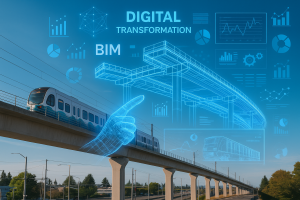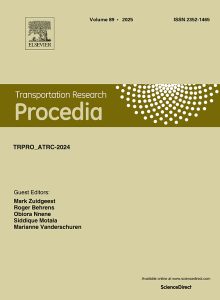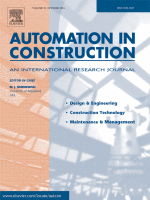18 “Building Smarter: The Role of BIM and Digital Technologies in Transforming Transportation Infrastructure”
Vinay Singh
Introduction
In recent years, the construction as well as infrastructure industry has witnessed a tremendous shift towards digitalization, with Building Information Modeling (BIM) emerging as a transformative force. This case study explores the broader application of BIM and associated digital technologies within large transportation infrastructure projects, with supporting examples from Sound Transit, a public transportation agency serving the Seattle metropolitan area.
As a graduate student in Construction Management at the University of Washington with a civil engineering background, I have long been interested in how complex infrastructure systems are planned, built, and managed. I had come across BIM during my engineering studies in India, but it wasn’t used as extensively there. It was only after starting my studies in the U.S. that I truly saw how powerful it can be. I realized that BIM isn’t just a tool—it’s a whole new way of thinking about how infrastructure projects are planned and built.
This case study combines academic research with practitioner insights, including an interview with a senior official from Sound Transit. The objective is to explore how BIM is transforming workflows, fostering collaboration, aiding in more informed decision-making, and elevating project results within the transportation industry.

Why this case matters?
Transportation infrastructure projects—such as metro systems, tunnels, highways, and railways—are large in scale and do have a very high-risk endeavors that require complex coordination between design, engineering, and construction disciplines. These type of projects frequently face changes in scope, broken communication, and technical disagreements that can prolong delivery times and increase expenses. Building Information Modeling (BIM), together with related technologies such as virtual reality (VR), geographic information systems (GIS), and the Internet of Things (IoT), can help eliminate these obstacles by offering a common, data-driven platform throughout the entire lifecycle of a project.
A study from 2023 published in Transportation Research Procedia highlights the growing adoption of BIM in civil infrastructure, emphasizing that BIM’s benefits extend beyond visualization to enhancing multi-disciplinary collaboration and managing the lifecycle of infrastructure systems.[1].

Understanding this transformation is critical for students, practitioners, and public stakeholders alike.
Motivation for the Problem / Research Question
Despite the increasing availability of BIM, many transportation projects continue to rely on 2D documentation, siloed teams, and outdated coordination processes. The core research question of this case study is:
How do BIM and digital technologies improve the design, construction, and operation of large transportation infrastructure projects, and in what ways do they enhance project efficiency and decision-making?
This question stems from my growing interest in the digital transformation of infrastructure and my own experience transitioning from conventional engineering tools to collaborative, data-driven environments. A 2018 review in Automation in Construction analyzed 189 publications and found that while BIM adoption in transportation is growing, it still trails behind vertical construction sectors. The review emphasized BIM’s potential in road, bridge, and railway infrastructure when integrated with lifecycle-based thinking and advanced technologies like digital twins [2].

Purpose
The purpose of this case study is to explore how BIM and supporting technologies (e.g., digital twins, 4D/5D simulation, cloud platforms) are applied across the lifecycle of transportation infrastructure projects. It seeks to:
- Identify ways in which BIM improves collaboration, visualization, and data use.
- Investigate its role in construction planning, asset management, and stakeholder engagement.
- Share practical lessons from real-world examples, including Sound Transit’s approach to project delivery.
Scope and Area of Emphasis
Although the case study highlights the practices of Sound Transit as a noteworthy example, its relevance extends beyond that organization. It emphasizes wider trends in the industry and various project types—such as highways, subways, and airports—that have effectively implemented BIM. The emphasis is on lifecycle integration, collaboration among stakeholders, and decision-making processes, rather than focusing on specific locations or individual projects.
Facts Related to the Case
- BIM is increasingly mandated in transportation infrastructure contracts across the world.
- Tools such as Revit, Navisworks, InfraWorks, and cloud-based collaboration platforms like Autodesk Construction Cloud are commonly used.
- Projects integrate 4D (time/schedule) and 5D (cost) BIM to visualize phasing and control budgets.
- Digital twins, combining IoT sensor data with 3D models, are used for operations and maintenance.
- VR/AR applications are helping design teams gather real-time feedback from operators and passengers.
- GIS integration allows asset managers to view performance data spatially across transit networks.
- Sound Transit uses BIM for all major projects and provided a detailed example of using the model during a tunnel emergency to calculate safe distances from high-voltage equipment.
How the research was conducted
Primary data was collected through a detailed, one-on-one interview (virtual via Zoom) with Justin Lopez, Deputy Director of AEC Technology at Sound Transit. The interview provided in-depth insight into how BIM is implemented in practice across various phases of transportation infrastructure projects. Key points include:
- BIM as a Mandatory Deliverable: Sound Transit mandates the use of BIM for all infrastructure and facility projects including stations, parking, and O&M facilities.
- Early Use for Stakeholder Engagement: BIM and VR were used to conduct immersive walkthroughs for operations staff and maintenance teams, enabling early feedback on access, spatial configuration, and feasibility of maintenance tasks.
- Pre-construction Accuracy: VR headsets helped identify impractical design elements such as glass façades that lacked maintenance access. Eye-tracking studies revealed signage visibility flaws, allowing early corrections.
- Construction Logistics: 4D modeling was used by contractors (via tools like Navisworks, Revit, and Tekla) to sequence work, assess steel installations, and visualize site constraints. Consultants were responsible for compiling and delivering VR-compatible models.
- Cost and Schedule Control: BIM models improved clash detection and avoided rework, though success varied depending on team skill level. An example of failure was given where an inexperienced contractor shifted their BIM model 100 feet upward to hide clashes rather than solve them.
- Emergency Operations Example: When the City of Seattle accidentally punctured the roof of Westlake Station, BIM was used to assess safe scaffolding clearance near high-voltage OCS systems. This avoided delays and enabled a rapid emergency response.
- Asset Management Integration: The agency is integrating BIM with GIS and IoT for long-term maintenance. Clicking on a model element links to live data dashboards for performance tracking.
- Digital Twin and Lifecycle Strategy: Models are developed from the preliminary stage with the goal of evolving into digital twins, forming a ‘single source of truth’ for operation and maintenance.
- Public Sector Realities: Justin shared that BIM adoption in public agencies requires strategic planning due to software contracting constraints, diverse jurisdictional needs, and varying levels of digital maturity.
- Sustainability Goals: BIM supports Sound Transit’s push toward net-zero operations by informing material choices, LEED strategies, and carbon impact modeling.
These first-hand experiences show how digital technologies are transforming not only processes but also the culture surrounding infrastructure development. They highlight the concrete results achievable when BIM is adopted with clear vision, strategic planning, and effective implementation.
Patterns and Theories Observed
Several recurring patterns emerged from the interview and secondary sources:
- Early Stakeholder Involvement: BIM tools like VR help capture user needs before construction.
- Data Centralization: A single coordinated model reduces errors and supports long-term operations.
- Digital Twin Strategy: Forward-looking agencies are turning BIM models into live assets.
- Training & Execution Gaps: The value of BIM depends heavily on team competence and contract clarity.
- Interoperability Standards: Open formats like IFC (Industry Foundation Classes) enable collaboration across platforms.
Connection to the Larger Scheme of Things
This case study reflects the AEC industry’s transition toward integrated digital delivery. As urban transportation needs evolve and budgets tighten, BIM offers a framework for smarter planning, faster construction, and better-maintained infrastructure. Its alignment with sustainability, resilience, and public transparency further elevates its relevance. By drawing from both research and industry voices, this study contributes to our understanding of what makes digital transformation in transportation truly successful.
References
-
Ali Pirdavani, Stephano Muzyka, Victor Vandervoort, Sander Van Hoye (2023). Application of building information modeling (BIM) for transportation infrastructure. Transportation Research Procedia, 73, 110-117. https://doi.org/10.1016/j.trpro.2023.11.898
-
Aaron Costin, Alireza Adibfar, Hanjin Hu, Stuart S. Chen (2018). A critical review of Building Information Modelling for transportation infrastructure. Automation in Construction, 94, 257-281. https://doi.org/10.1016/j.autcon.2018.07.001
-
Interview with Justin Lopez, Deputy Director – AEC Technology, Sound Transit, conducted May 2025.
-
Sound Transit Project Delivery Guidelines. https://www.soundtransit.org/get-to-know-us/doing-business-with-us/project-delivery-standards
-
Autodesk, “What is BIM?” https://www.autodesk.com/solutions/bim
-
National Institute of Building Sciences, “BIM Project Execution Planning Guide.”
-
UK BIM Alliance. “BIM in Infrastructure Projects.”
Media Attributions
- Digital Transformation:BIM
- Procedia
- Automation in Construction


